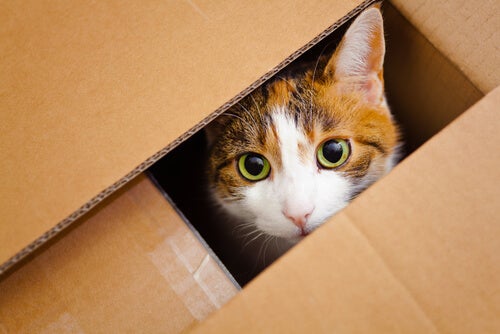How to Get Rid of the Smell of Cat Urine in Your Home


Written and verified by the biologist Ana Díaz Maqueda
The strong smell of cat urine is a well-known characteristic of this species. Any cat owner is perfectly aware of just how unpleasant a task it is to change a cat’s litter box.
But what’s even worse is when cats–for a variety of reasons–urinate outside of their litter box and around your home. Getting rid of the smell is often a major challenge. What’s more, it can also be very difficult to keep your cat from repeating this behavior.
Just as in the case of dog urine, getting rid of the smell and your cat’s bad habit can seem like mission impossible. That’s why today My Animals will tell you just how to eliminate the smell of cat urine from your home.
Why does my cat urinate outside of the litter box?
From the time cats are very small, they learn to poop and urinate independently. They seek out a place to go to take care of their needs and don’t need their mother to clean them. This makes it very easy to teach kittens to use a litter box. You just place them inside once their done eating. Another helpful tip is to stimulate their genital region with a wet towel (simulating the mother’s tongue).
At the same time, when adopting adult cats that are used to living on the street, you just need to show them the location of their litter box. Make sure to use the right kind of litter and place the box in a peaceful area. If you do, then your cat shouldn’t have any trouble adapting to the new situation.
Because cats learn to use the litter box so easily, it’s not normal for them to go to the toilet anywhere else. Therefore, if this occurs, it’s important to analyze the situation and look for an explanation. And, of course, you should take your cat to the vet. There are various reasons that can cause cats to urinate outside of their litter box, as you can see below:
Male cats that are not neutered
A non-neutered male cat, upon reaching adulthood, will begin marking his territory by expulsing pseudouridine. This isn’t bad or unhealthy behavior, and doesn’t mean your cat has a problem. But if you want it to stop, then you’ll need to neuter your cat.

Non-spayed female cats
Just like their male counterparts, female cats mark their territory. However, they only do so when they are in heat. As cats are seasonally polyestrous, they often have multiple cycles during the breeding period – one after the other. At the same time, when female cats are not spayed, this increases their chances of suffering urinary infections.
Urinary tract infections
Given their nature, cats don’t need to drink a great deal of water. This is because they are able to concentrate their urine and thus avoid water loss. As a result, this animal species tends to suffer renal problems and problems with the urinary tract. This includes kidney stones as well as urinary infections and other issues. When cats are ill, the pain and difficulty that urinating entails can cause them to urinate just about anywhere.
Behavior problems
Stress is one of the main reasons why cats urinate outside of their litter boxes. Moving to another home, the arrival of new family members, and other changes can cause cats to feel deeply upset. As a result, they may end up going to the bathroom where they shouldn’t.

The composition of cat urine
Cat urine isn’t just damaging to different surfaces, it also has a very strong and persistent smell. This has to do with its low pH, making it a very acidic substance.
At the same time, cat urine has a high concentration of uric acid and urea as a result of their 100% carnivorous diet. Along with an elevated percentage of ammonia, this makes the smell of cat urine very penetrating. Below, you can observe the different values of the various substances that make up cat urine. The information in the table comes from a 2002 study by Cottam and Weller:
| Males | Females | |||
| Mean ± SEM | Range | Mean ± SEM | Range | |
| pH | 6,37*± 0,07 | 5.73–7.39 | 5.97 ± 0.10 | 5.54–6.57 |
| Specific gravity, g / L | 1.048 ± 0.002 | 1.017–1.065 | 1.045 ± 0.002 | 1.016–1.064 |
| Osmolality, mOsm / kg | 2084 ± 99 | 665–3178 | 1911 ± 130 | 638–3124 |
| Creatinine, mM | 16,2*± 1,0 | 4.8–32.3 | 12.0 ± 1.3 | 3.3–27.8 |
| Total nitrogen, mM | 3085 ± 185 | 634–5411 | 2816 ± 243 | 746–5491 |
| Protein, mg / L | 375 ± 39 | 30-1152 | 305 ± 51 | 73–978 |
| Urea, mM | 1386 ± 83 | 253–2235 | 1295 ± 109 | 315–2255 |
| Uric acid, mM | 0,52 ± 0,05 | 0.01–1.35 | 0.39 ± 0.06 | 0.01–0.98 |
| Ammonia, mM | 118 ± 9.2 | 16.9–292 | 121 ± 12,2 | 31–262 |
| Calcium, mM | 0.69 ± 0.08 | 0.10–2.90 | 0.82 ± 0.11 | 0.20–2.80 |
| Magnesium, mM | 3.11†± 0.29 | 0.65–7.22 | 3.94 ± 0.37 | 0.99–10.94 |
| Phosphate, mM | 81 ± 5.3 | 6–164 | 77 ± 7.0 | 16-150 |
Products to avoid when cleaning cat urine in your home
When we want to clean something thoroughly, most of us reach for products like bleach, also known as sodium hypochlorite. If you use this compound to clean up cat urine, then you’ll achieve part of what you’re trying to do. That is, you’ll manage to disinfect the area.
However, a strong love relationship exists between bleach and cats. While this sounds hard to believe, cats react to bleach in much the same way that they react to catnip or valerian.
While not every cat is prone to this reaction, it occurs in 75% of cats and has to do with genetic factors. And not only that, bleach is very toxic to felines. Therefore, we definitely don’t recommend using bleach to clean up cat urine.
Another product you need to be sure to avoid when cleaning cat urine is ammonia. Despite the fact that this substance is a good disinfectant, the above table reveals that cat urine already contains a high quantity of ammonia. Therefore, using ammonia to clean up after your cat will only encourage him or her to continue urinating in the same spot.
How to eliminate the smell of cat urine in your home
So, what can you do if you want to clean effectively, remove the smell of cat urine, and keep your cat from urinating wherever he or she pleases? What you need to do is use enzymatic cleansers or those with active oxygen. These products actually decompose urine and make it impossible for cats to identify the substance.
Just the same, as we said, the fact that a cat urinates outside of the litter box is not normal behavior…unless, of course, the animal is not spayed or neutered. Therefore, if you observe this behavior in your pet, then you should be sure to make a visit to your veterinarian.
All cited sources were thoroughly reviewed by our team to ensure their quality, reliability, currency, and validity. The bibliography of this article was considered reliable and of academic or scientific accuracy.
- Colurciello, A. F., & Weller, J. M. (1995). U.S. Patent No. 5,395,555. Washington, DC: U.S. Patent and Trademark Office.
- Cottam, Y. H., Caley, P., Wamberg, S., & Hendriks, W. H. (2002). Feline reference values for urine composition. The Journal of nutrition, 132(6), 1754S-1756S.
- Everhart, W. C. (2015). U.S. Patent No. 9,149,019. Washington, DC: U.S. Patent and Trademark Office.
- Pryor, P. A., Hart, B. L., Bain, M. J., & Cliff, K. D. (2001). Causes of urine marking in cats and effects of environmental management on frequency of marking. Journal of the American Veterinary Medical Association, 219(12), 1709-1713.
This text is provided for informational purposes only and does not replace consultation with a professional. If in doubt, consult your specialist.